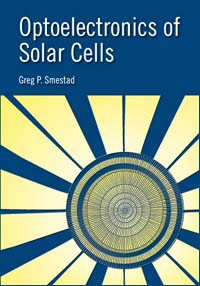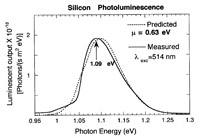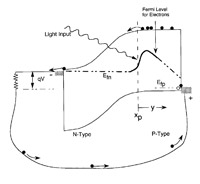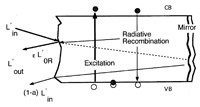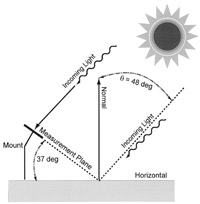Optoelectronics of Solar Cells, by Greg Smestad, can be ordered below. In addition, an addendum is provided to update a few aspects based on more recent information.
Solar cells have already proven themselves a viable option as a nonpolluting renewable energy source in many applications. It is advantageous to optical engineers to have at least a basic knowledge of how these devices function, and of the important parameters that control their operation. Optoelectronics of Solar Cells is designed to be an overview for those in the fields of optics and optical engineering, as well as those who are interested in energy policy, economics, and the requirements for efficient photo-to-electric energy conversion.
The book was developed from conference courses taught by the author for SPIE, and was inspired by his numerous publications.
Contents
List of Symbols and Terms / ix
Preface / xv
Chapter 1 Introduction to Solar Cells / 1
1.1 Philosophy of the Text / 1
1.2 Renewable Energy and Photovoltaics Background / 2
1.3 What is a Solar Cell? / 4
1.4 Solar Cell Modules / 10
Chapter 2 Absorbing Solar Energy / 15 (sample chapter)
2.1 Air Mass and the Solar Spectrum / 15
2.2 Optical Properties of Solar-Cell Materials / 19
2.2.1 Absorptivity / 19
2.2.2 Absorption coefficient / 20
2.2.3 Solar cell bandgap / 23
2.2.4 Antireflection coatings / 26
2.2.5 Thickness determination / 29
2.2.6 Predicting absorptivity / 30
2.3 Photoluminescence / 32
Chapter 3 Solar Cell Equations / 37
3.1 PV Device Characteristics / 37
3.2 Quantum Efficiency for Current Collection / 41
3.3 Lifetime, Diffusion Length, and Electron Concentrations / 44
3.4 The Transport Equation and Current Extraction / 46
Chapter 4 Photoelectrochemistry / 51
4.1 Basic Photoelectrochemistry / 51
4.2 The Dye-Sensitized Nanocrystalline Solar Cell / 51
Chapter 5 Generalized Model of a Solar Converter / 57
5.1 General Thermodynamics of Light Conversion / 57
5.2 Detailed Balance: The Generalized Planck Equation / 59
5.3 The Luminescent Output / 65
5.4 The Relationship Between Voltage and Luminescence Efficiency / 66
5.5 Current-Voltage Characteristics and Luminescence / 67
Chapter 6 Concentrators of Light / 71
6.1 The Thermodynamic Limits of Light Concentrators / 71
6.2 Geometrical Optics / 71
6.2.1 General theory and sine brightness law / 71
6.2.2 Examples of ideal geometric concentrators / 73
6.3 Active Concentrators (Luminescent Systems) / 77
6.3.1 Theory of luminescent systems / 77
6.4 Light Enhancement in the Environment / 78
Chapter 7 Basic Economics of Photovoltaic Cells and Systems / 81 (pdf)
7.1 The Basics of PV Economics / 81
7.2 Estimated Solar Module Cost / 82
7.3 Economics of Photovoltaic Systems / 83
7.4 Economics of Renewable Energy in the World Economy / 85
7.5 Conclusions and Further Study / 90
Appendix / 91
A Basic Solar Energy Library for the Optical Specialist / 93 (pdf)
Index / 97
Addendum / on-line
Chapter 7 Update: Some numerical values used (e.g., cell $/m2) have decreased over time, but the equations themselves are unchanged.
G. P. Smestad, “The Basic Economics of Photovoltaics for Vacuum Coaters,” 52nd Annual Technical Conference Proceedings, Society of Vacuum Coaters, Santa Clara, CA, May 9 – 14, 2009. Download Article
Study of Potential Cost Reductions Resulting from Super-Large-Scale Manufacturing of PV Modules, 2004. (download at NREL).
NREL Solar Manufacturing Cost Analysis – This presents a more complete picture with more up-to-date input values, and includes the concept of a PV module minimum sustainable price.
Advanced Topics
29 June 2017 – “Chemistry, materials science and technology related to photovoltaic, and photoelectrochemical solar energy conversion,” Presented as part of the USPTO’s Patent Examiner Technical Training Program; G. P. Smestad View Presentation on Slideshare.
Soiling consists of mineral dust, soot particles, aerosols, pollen, fungi and other contaminants that deposit on the surface of PV modules. The accumulation of soiling on photovoltaic (PV) modules affects PV systems worldwide. Learn more
Optoelectronics of Solar Cells
SPIE Monograph PM115,
by Greg P. Smestad
ISBN 0-8194-4440-5
118 pages; Pub. July 2002; Softcover;
In print, $34 SPIE members/$42 non-members.
Order the book from SPIE or from Amazon.com.




